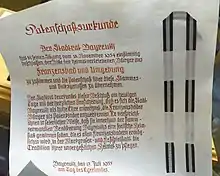
Volksgenosse (plural Volksgenossen) is a German language term meaning a fellow member of a community or compatriot (translated literally as people's comrade). The word was recorded as early as 1798 and its usage grew within the Völkisch movement of German ethnic nationalism, which led to its use to denote a person of the same "blood community".[1] The term became common parlance within the Nazi Party, then the Third Reich, as a way to distinguish ethnic Germans from other groups, such as Jews and Gypsies. Due to these associations, the word gradually fell out of use after Germany's defeat in World War II and subsequent denazification efforts.[2]
Volksgenosse was formalised in point 4 of the Nazi Party's 25-point Program in 1920 as a racial ideological term: "Only a Volksgenosse can be a citizen. Volksgenossen are only those of German blood, regardless of denomination. No Jew can therefore be a Volksgenosse".[3][4]
Adolf Hitler extended the racial connections with phrases such as "Volks- und Rassegenossen" and "rassen- und nationalbewußten Volksgenossen" (race- and nation-conscious Volksgenossen) in his 1924 book Mein Kampf. This was to further differentiate it from the more inclusive, general term Genosse (comrade) which was being used by members of both the Social Democratic Party of Germany and the Communist Party of Germany.
After 1933, Volksgenosse became a much-used buzzword in the Third Reich, which was used as an opening at speeches and rallies. From the outset, the term excluded people on a race basis and it also took on a status that excluded the Black triangle groups (including the disabled, sex and gender minorities, alcoholics, homeless, beggars and sex workers). Population groups that are classified as "anti-social" or disabled were not considered to be peers.[5] The Winterhilfswerk appeals for charity were marketed as an appeal to the common sense of the Volksgenossen.
In the early years of the Nazi regime, Slavs were also considered to be of "related blood" to Germans.[6][7] This position later changed with the so-called Polish decrees of 8 March 1940 and made explicit in the secret order of the Reichsführer-SS Heinrich Himmler on 23 March 1942, who noted the "clear demarcation of the non-Germanic peoples, especially from the Slavs and Fremdarbeiter (foreign workers), who for racial reasons are members of non-Germanic peoples to be regarded as capable of Germanisation."[8][9] There was no binding definition of Volksgenosse in this regard.[10] Although ideas of belonging to the German people traditionally relied on ethnic, cultural and denominational similarities, a special position was granted to other "Germanic peoples", such as Scandinavians, Dutch and Flemish people. They were regarded as belonging to the same racial family with the long-term aim being that these people be "transferred spiritually to the imperial unity and biologically into a common blood body with the German people".[11][6]
The earlier German citizenship law of 1913 used jus sanguinis (right of blood) to determine the inheritance of citizenship. It did not explicitly incorporate the racial notions found within the Nuremberg Laws established by the Nazis in 1935, though the Reich and Citizenship Act (RuStAG) was not formally changed as non-Volksgenosse are stripped of citizenship and given the diminished status of subjects of the state.[12]
See also
References
- ↑ Cornelia Schmitz-Berning: Vokabular des Nationalsozialismus. 2. durchges. u. überarb. Aufl., Berlin 2007, ISBN 978-3-11-019549-1, S. 660 f.
- ↑ Cornelia Schmitz-Berning: Vokabular des Nationalsozialismus, p. 664.
- ↑ „Staatsbürger kann nur sein, wer Volksgenosse ist. Volksgenosse kann nur sein, wer deutschen Blutes ist, ohne Rücksichtnahme auf die Konfession. Kein Jude kann daher Volksgenosse sein.“
- ↑ Das 25-Punkte-Programm auf LeMO
- ↑ Vgl. Wolfgang Ayaß: „Demnach ist zum Beispiel asozial…“. Zur Sprache sozialer Ausgrenzung im Nationalsozialismus, in: Beiträge zur Geschichte des Nationalsozialismus 28 (2012), S. 69–89.
- 1 2 Isabel Heinemann: „Rasse, Siedlung, deutsches Blut“: Das Rasse- & Siedlungshauptamt der SS und die rassenpolitische Neuordnung Europas, 2. Aufl., Wallstein Verlag, Göttingen 2003, ISBN 3-89244-623-7, S. 476.
- ↑ "Bisher sei ‚das Blut aller Völker, die geschlossen in Europa siedeln, als artverwandt‘ bezeichnet worden. […] ‚Artverwandten nichtstammesgleichen Blutes‘ waren alle nichtgermanischen europäischen Völker: slawische, romanische, keltische, baltische Völker." Zit. nach Josef Goldberger, Oberösterreichisches Landesarchiv (Hrsg.): NS-Gesundheitspolitik in Oberdonau: Die administrative Konstruktion des „Minderwertes“, OÖLA, 2004, ISBN 3-900-31372-5, S. 201.
- ↑ Helmut Heiber, Institut für Zeitgeschichte (Hrsg.): Akten der Partei-Kanzlei der NSDAP, Band 1, Teil 1, RKF 15680 – K 101 13763 f. (722), Oldenbourg, München 1983, S. 671.
- ↑ Vgl. Isabel Heinemann: „Rasse, Siedlung, deutsches Blut“: Das Rasse- & Siedlungshauptamt der SS und die rassenpolitische Neuordnung Europas, 2. Aufl., Wallstein Verlag, Göttingen 2003, ISBN 3-89244-623-7, S. 477 ff.
- ↑ Siehe zu alledem Cornelia Schmitz-Berning: Vokabular des Nationalsozialismus, de Gruyter, Nachdr. der Ausg. von 1998, Berlin/New York 2000, ISBN 3-11-016888-X, S. 70 f., 149 f., 508, 662 f. m.w.N.
- ↑ Siehe hierzu insbes. Isabel Heinemann, ibid., S. 341 ff.
- ↑ Vgl. Ingo von Münch: Die deutsche Staatsangehörigkeit: Vergangenheit – Gegenwart – Zukunft, Walter de Gruyter, Berlin 2007, ISBN 978-3-89949-433-4, S. 149 f.